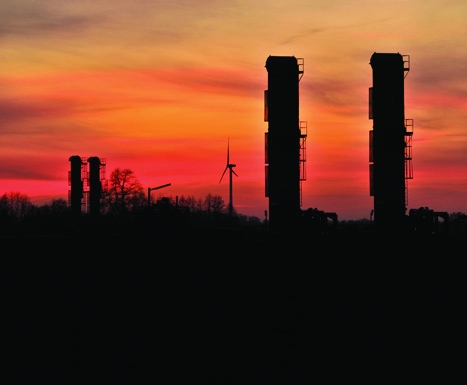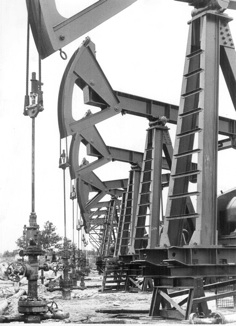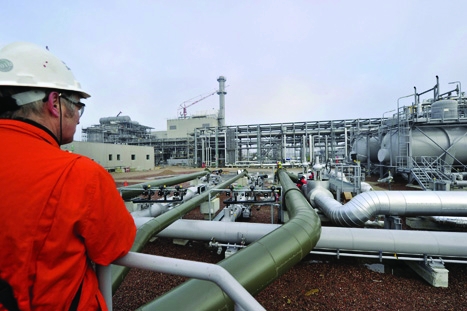
Relatively unknown beyond the Netherlands, the small village of Schoonebeek occupies a special place in Dutch hearts. As the site of the country’s first oil discovery, this quiet, rural community, nestling on the German border, has become something of a monument to the Dutch oil industry.
Local shops sell souvenir mugs, T-shirts and even cakes celebrating the village’s links with the black stuff. And if you ask nicely, the man in the post office will switch on the ’nodding donkey’ that takes pride of place in the village square.
It may seem an unlikely tourist destination, but Schoonebeek’s significance shouldn’t be understated. Between 1947 and 1996, the village was at the centre of one of the largest onshore oil fields in Europe; a facility that helped fuel the growth of the Netherlands’ biggest industry and one of the world’s largest companies: Shell.
Despite only recovering around 20 per cent of the oil, the oil field’s operator, NAM (a joint venture between Shell and Exxonmobil), ceased production from the site in 1996 when the high cost of extracting the remaining highly viscous oil simply couldn’t be justified given the easier pickings elsewhere.
But earlier this year, thanks to an advanced new facility that pumps steam via horizontal wells hundreds of metres beneath the surface, Schoonebeek’s oil began to flow once again and its operators now hope to extract a further 120 million barrels over the next 25 years.
The easy oil is disappearing and the new oil fields are expensiveDiederik Boersma, Shell R&D
The oil field’s rebirth is part of a wider trend in the fossil-fuel industry. Much of the planet’s untapped reserves are either deep beneath the sea or in environmentally sensitive areas. This has triggered a revaluation of many previously abandoned oil fields and given momentum to a suite of enhanced oil recovery (EOR) techniques that will bring it to the surface.
’The easy oil is disappearing,’ said Diederik Boersma, Shell’s R&D team leader for EOR. ’All the new oil fields that you find are in the Arctic or in the water; it’s expensive. And because the new oil is expensive, going back to your existing oil fields and using EOR becomes very attractive. One of the uncertainties in oil-field development is finding the oil; that uncertainty is not there if you go to existing oil fields.’

Traditionally, oil fields have largely been exploited through natural depletion: engineers drill a hole and the pressure in the reservoir forces out the oil. This typically leaves around 80 per cent of the oil in the ground, so energy companies then inject water or gas into the reservoir to force out more of the oil, boosting the recovery factor to around 30 per cent.
But this is only successful up to a point. Water will follow the path of least resistance, leaving some areas of a reservoir untouched. And differences in viscosity and the effect of microscopic interactions between water and oil can also hamper recovery. EOR — a range of technologies that typically use chemicals, miscible gas or heat to alter the properties of the reservoir fluids — could, some claim, boost the recovery factor to as much as 70 per cent.
Although EOR tends to be seen as a relatively modern solution to the problem of dwindling oil reserves, it’s actually been around for quite some time. Indeed, Shell first began putting steam into reservoirs in the 1930s. ’There was a lot of development all the way up until the 1980s, but then there was a big oil price crash and a lot of EOR was shelved,’ said Boersma. The rise of the supercomputer and the ability to model sub-surface wells also killed off many of the experimental EOR projects.
Now, with oil prices rising and concerns over future energy supply mounting, the technology once more has some momentum behind it and the Schoonebeek project, which uses a form of thermal EOR, is a compelling illustration of the technology’s benefits.
At the facility, ultra-pure water from a nearby sewage-treatment plant is piped underground to a 120MW co-generation plant where it’s heated to become steam. This is pumped into 25 horizontal steam-injection wells around 800m beneath the surface. The oil, which sits under an impermeable layer of clay, heats up, becomes less viscous and begins to flow.
The resulting mixture of oil, water and natural gas is pumped upwards using high-capacity pumping units. First the natural gas is extracted and piped back to the co-generation plant where it is used to generate electricity. Then the oil and water are separated, the water pumped back into nearby depleted gas fields and the oil sent along a pipeline to a BP refinery in the German town of Lingen.
According to NAM’s Michael Lander, project manager for the development, one of the key features of Schoonebeek is the horizontal wells that stretch beneath the oil field. ’In the old days, we just had vertical wells and contact with the reservoir was relatively small compared with these wells, which go 800m down then 800m in the horizontal.’ Lander also hailed the benefits of the highly efficient long-shot pumping units used to suck the oil out of the wells. With a pump stroke of 9.2m, these units are able to extract three to four times more oil than traditional pumps and 40 of them have been used to replace 250 nodding donkeys.
Efforts are currently focused on the western section of the field, which Shell believes will yield a further 120 million barrels over the next 20 years. However, the company predicts that the eastern end of the field, which is still being developed, could yield a similar amount and is investigating the use of alternative EOR techniques to exploit it.

Although Schoonebeek is something of a flagship project for Shell, thermal EOR using steam injection is just one of a number of techniques that are currently being deployed around the world and, according to Boersma, the technology used depends on a number of factors. ’If it’s buried 4,000m deep you have high pressure, high temperature; you have different conditions. Certain chemicals will disintegrate at high temperatures. For steam injection, you want to be in a low-pressure environment as generating steam at high pressure is very difficult and inefficient.’
In Oman, which Boersma describes as ’something of a Valhalla for EOR’, the company recently began a polymer flood project where hundreds of thousands of barrels of polymer solution are used to increase the viscosity of the water and improve the recovery factor. As well as chemical and thermal techniques, a range of other, more experimental, approaches are being considered, such as air injection, or even the energy-intensive use of well-based heating elements.
Generating steam at high pressure is very difficult and inefficientDiederick Boersma
Boersma added that Shell is also actively looking at combining elements from different EOR techniques. One particularly intriguing hybrid approach to EOR is being developed in the US by Chevron Technology Ventures, which recently launched a demonstration project looking at the use of solar energy to produce oil.
Based at California’s Coalinga field, the project — which is the largest of its kind in the world — uses more than 7,600 mirrors to focus the sun’s energy onto a solar boiler. The steam produced is injected into oil reservoirs to increase production.
Like Schoonebeek, Coalinga began operating in the 1890s, but because the heavy crude oil produced at the site doesn’t flow readily Chevron has been enhancing production by injecting steam to reduce the oil’s viscosity. This steam is currently being generated by burning natural gas, but Chevron claims that solar-to-steam technology could help dramatically improve the commercial viability of thermal EOR.
There is also growing interest in using EOR to improve recovery factors from offshore fields. Indeed, Shell and Petronas are currently looking at developing the world’s first field-scale offshore chemical EOR project in Malaysia, while BP has been using gas-injection EOR to extract oil from the North Sea’s Magnus oil field since 2003.
However, there seems to be a general feeling that the technology must first be proven and refined on shore before it becomes truly economically compelling for offshore use. ’The challenging thing with offshore EOR is that you often develop fewer wells off shore,’ said Boersma, ’so the time from injection to production is longer, often making it marginal in economic terms.’
Despite this, there seems little doubt that the fevered rate of technology development in the oil and gas industry will make EOR increasingly economically viable for a growing range of reservoirs. Current estimates for the percentage of oil that can be recovered using EOR vary between 50 and 70 per cent compared with the average 20 per cent achieved using natural depletion. But ultimately, Boersma sees no limits to what could be achieved.
in depth
oil rush
EOR involves injecting steam, chemicals or gas into the reservoir to ease the flow of oil. Oil producers typically only manage to recover around a third of a reservoir’s oil: the rest is left in the ground. According to the International Energy Agency, boosting oil recovery could help to unlock 300 billion more barrels of oil, equal to 10 years’ production.
Injecting steam, chemicals or gas into a reservoir — a process called enhanced oil recovery (EOR) — eases the flow of oil and boosts recovery by an average of 10 per cent.
- Gas injection: the most widely used EOR technique, gas injection can be used to boost the pressure in a well as well as reduce the viscosity of oil by mixing with it.
- Chemical injection: a range of chemicals, usually injected in solution, can be used to increase production. Soluble polymers can be used to boost recovery by increasing the viscosity of injected water, while solutions of surfactants can help reduce the capillary forces that impede oil droplets from moving through a reservoir.
- Thermal EOR: various approaches can be used to heat oil in order to reduce its viscosity and encourage it to flow. Steam injection, which has been used commercially since the 1960s, is the most widely used thermal EOR technique.
in depthreservoir clogs
BP Bright Water technology is used to optimise the flow of water as it passes through the reservoirInjecting water into reservoirs is a standard technique for recovering more oil. But ensuring that water passes uniformly through the porous reservoir and doesn’t simply take the path of least resistance limits the effectiveness of the approach.
One possible solution to this is BP Bright Water technology, which injects tiny sub-micron particles of thermally activated polymer into the water.
This dispersion flows with the water and warms as it passes through the reservoir, heating fastest in layers where the water has pushed ahead of the main flood and is flowing between unswept rock above and below. In these areas, the polymer pops open and blocks the better-swept zones deep in a reservoir, diverting water to previously relatively untouched zones.
Initial field trials of the technology were carried out in Alaska, with more than 25 treatments in waterflood operations in Alaska, Argentina and Pakistan. So far, these have delivered an increase of more than six million barrels of reserves at a development cost of less than $6 (£3.80) per barrel.




Glasgow trial explores AR cues for autonomous road safety
They've ploughed into a few vulnerable road users in the past. Making that less likely will make it spectacularly easy to stop the traffic for...